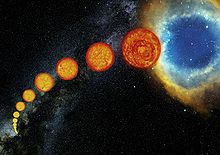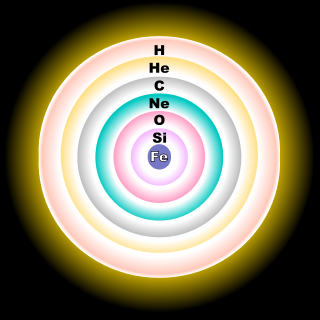- Stellar evolution
-
Stellar evolution is the process by which a star undergoes a sequence of radical changes during its lifetime. Depending on the mass of the star, this lifetime ranges from only a few million years (for the most massive) to trillions of years (for the least massive, which is considerably more than the age of the universe).
Stellar evolution is not studied by observing the life of a single star, as most stellar changes occur too slowly to be detected, even over many centuries. Instead, astrophysicists come to understand how stars evolve by observing numerous stars at the various points in their life, and by simulating stellar structure with computer models.
Contents
Birth of a star
Main article: Star formation A dense starfield in Sagittarius
A dense starfield in Sagittarius
Protostar
Stellar evolution begins with the gravitational collapse of a giant molecular cloud (GMC). Typical GMCs are roughly 100 light-years (9.5×1014 km) across and contain up to 6,000,000 solar masses (1.2×1037 kg). As it collapses, a GMC breaks into smaller and smaller pieces. In each of these fragments, the collapsing gas releases gravitational potential energy as heat. As its temperature and pressure increase, a fragment condenses into a rotating sphere of superhot gas known as a protostar.[1]
The further development heavily depends on the mass of the evolving protostar; in the following, the protostar mass is compared to the solar mass: 1.0 M☉ (2.0×1030 kg) means 1 solar mass.
Brown dwarfs and sub-stellar objects
Protostars with masses less than roughly 0.08 M☉ (1.6×1029 kg) never reach temperatures high enough for nuclear fusion of hydrogen to begin. These are known as brown dwarfs. Brown dwarfs heavier than 13 Jupiter masses (2.5 × 1028 kg) or 0.0125 solar mass fuse deuterium, and some astronomers prefer to call only these objects brown dwarfs, classifying anything larger than a planet but smaller than this a sub-stellar object. Both types, deuterium-burning or not, shine dimly and die away slowly, cooling gradually over hundreds of millions of years.
Hydrogen fusion
For a more massive protostar, the core temperature will eventually reach 10 million kelvins, initiating the proton-proton chain reaction and allowing hydrogen to fuse, first to deuterium and then to helium. In stars of slightly over 1 M☉ (2.0×1030 kg), the CNO cycle contributes a considerable portion of the energy generation. The onset of nuclear fusion leads relatively quickly to a hydrostatic equilibrium in which energy released by the core exerts a "radiation pressure" balancing the weight of the star's matter, preventing further gravitational collapse. The star thus evolves rapidly to a stable state, beginning the main sequence phase of its evolution.
A new star will fall at a specific point on the main sequence of the Hertzsprung-Russell diagram, with the main sequence spectral type depending upon the mass of the star. Small, relatively cold, low mass red dwarfs burn hydrogen slowly and will remain on the main sequence for hundreds of billions of years, while massive, hot supergiants will leave the main sequence after just a few million years. A mid-sized star like the Sun will remain on the main sequence for about 10 billion years. The Sun is thought to be in the middle of its lifespan; thus, it is on the main sequence.
 Internal structures of main sequence stars, convection zones with arrowed cycles and radiative zones with red flashes. To the left a low-mass red dwarf, in the center a mid-sized yellow dwarf and at the right a massive blue-white main sequence star.
Internal structures of main sequence stars, convection zones with arrowed cycles and radiative zones with red flashes. To the left a low-mass red dwarf, in the center a mid-sized yellow dwarf and at the right a massive blue-white main sequence star.
Maturity of a star
A mid-sized star like the Sun will remain on the main sequence for about 10 billion years. Eventually, the core exhausts its supply of hydrogen, and moves off the main sequence (if it was there at all). Without the outward pressure generated by the fusion of hydrogen to counteract the force of gravity, it contracts until either electron degeneracy becomes sufficient to oppose gravity or the core becomes hot enough (around 100 megakelvins) for helium fusion to begin. Which of these happens first depends upon the star's mass.
Low-mass stars
What happens after a low-mass star ceases to produce energy through fusion is not directly known: the universe is thought to be around 13.7 billion years old, which is less time (by several orders of magnitude, in some cases) than it takes for the fusion to cease in such stars. Current theory is based on computer modelling done by astronomers such as Don VandenBerg.
Some stars may fuse helium in core hot-spots, causing an unstable and uneven reaction as well as a heavy solar wind. In this case, the star will form no planetary nebula but simply evaporate, leaving little more than a brown dwarf.[citation needed]
A star of less than about 0.5 solar mass will never be able to fuse helium even after the core ceases hydrogen fusion. There simply is not a stellar envelope massive enough to exert enough pressure on the core. These are the red dwarfs, such as Proxima Centauri, some of which will live thousands of times longer than the Sun. Recent astrophysical models suggest that red dwarfs of 0.1 solar mass may stay on the main sequence for almost six trillion years, and take several hundred billion more to slowly collapse into a white dwarf.[2] If a star's core becomes stagnant (as is thought will be the case for the Sun), it will still be surrounded by layers of hydrogen which the star may subsequently draw upon. However, if the star is fully convective (as thought to be the case for the lowest-mass stars), it will not have such surrounding layers. If it does, it will develop into a red giant as described for mid-sized stars below, but never fuse helium as they do; otherwise, it will simply contract until electron degeneracy pressure halts its collapse, thus directly turning into a white dwarf.
Mid-sized stars
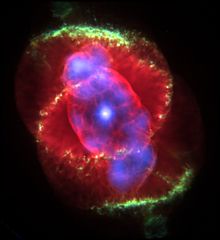 The Cat's Eye Nebula, a planetary nebula formed by the death of a star with about the same mass as the Sun
The Cat's Eye Nebula, a planetary nebula formed by the death of a star with about the same mass as the Sun
Stars of roughly 0.5–10 solar masses become red giants of two types. Red giant branch stars (RGB stars) whose shells are still fusing hydrogen into helium, while the core is inactive helium. They have reached hydrostatic equilibrium, where electron degeneracy pressure is sufficient to balance gravitational pressure. Asymptotic giant branch have a core undergoing helium fusion, producing carbon. In either case, the accelerated fusion in the hydrogen-containing layer immediately over the core causes the star to expand. This lifts the outer layers away from the core, reducing the gravitational pull on them, and they expand faster than the energy production increases. This causes them to cool, which causes the star to become redder than when it was on the main sequence.
According to the Hertzsprung-Russell diagram, a red giant is a large non-main sequence star of stellar classification K or M. Examples include Aldebaran in the constellation Taurus and Arcturus in the constellation of Boötes.
A star of up to a few solar masses will develop a helium core supported by electron degeneracy pressure, surrounded by layers which still contain hydrogen. Its gravity compresses the hydrogen in the layer immediately above it, causing it to fuse faster than hydrogen would fuse in a main-sequence star of the same mass. This in turn causes the star to become more luminous (from 1,000–10,000 times brighter) and expand; the degree of expansion outstrips the increase in luminosity, causing the effective temperature to decrease.
The expanding outer layers of the star are convective, with the material being mixed by turbulence from near the fusing regions up to the surface of the star. For all but the lowest-mass stars, the fused material has remained deep in the stellar interior prior to this point, so the convecting envelope makes fusion products visible at the star's surface for the first time. At this stage of evolution, the results are subtle, with the largest effects, alterations to the isotopes of hydrogen and helium, being unobservable. The effects of the CNO cycle appear at the surface, with lower 12C/13C ratios and altered proportions of carbon and nitrogen. These are detectable with spectroscopy and have been measured for many evolved stars.
 Simplified illustration of the evolution of a star with the mass of the Sun.
Simplified illustration of the evolution of a star with the mass of the Sun.
The star forms from a collapsing cloud of gas (1),
and then undergoes a contraction period as a protostar (2),
before joining the main sequence (3).
Once the Hydrogen at the core is consumed it expands into a red giant (4),
then sheds its envelope into a planetary nebula and degenerates into a white dwarf (5).As the hydrogen around the core is consumed, the core absorbs the resulting helium, causing it to contract further, which in turn causes the remaining hydrogen to fuse even faster. This eventually leads to ignition of helium fusion (which includes the triple-alpha process) in the core. In stars of more than approximately 0.5 solar masses, electron degeneracy pressure may delay helium fusion for millions or tens of millions of years; in more massive stars, the combined weight of the helium core and the overlying layers means that such pressure is not sufficient to delay the process significantly.
When the temperature and pressure in the core become sufficient to ignite helium fusion in the core, a helium flash will occur if the core is largely supported by electron degeneracy pressure (stars under 1.4 solar masses). In more massive stars, whose core is not overwhelmingly supported by electron degeneracy pressure, the ignition of helium fusion occurs relatively quietly. Even if a helium flash does occur, the time of very rapid energy release (on the order of 108 Suns) is brief, so that the visible outer layers of the star are relatively undisturbed.[3] The energy released by helium fusion causes the core to expand, so that hydrogen fusion in the overlying layers slows and total energy generation decreases. The star contracts, although not all the way to the main sequence, and it migrates to the horizontal branch on the HR-diagram, gradually shrinking in radius and increasing its surface temperature.
After the star has consumed the helium at the core, fusion continues in a shell around a hot core of carbon and oxygen. The star follows the Asymptotic Giant Branch on the HR-diagram, paralleling the original red giant evolution, but with even faster energy generation (which lasts for a shorter time).[4]
Changes in the energy output cause the star to change in size and temperature for certain periods. The energy output itself is shifted to lower frequency emission. This is accompanied by increased mass loss through powerful stellar winds and violent pulsations. Stars in this phase of life are called Late type stars, OH-IR stars or Mira-type stars, depending on their exact characteristics. The expelled gas is relatively rich in heavy elements created within the star and may be particularly oxygen or carbon enriched, depending on the type of the star. The gas builds up in an expanding shell called a circumstellar envelope and cools as it moves away from the star, allowing dust particles and molecules to form. With the high infrared energy input from the central star, ideal conditions are formed in these circumstellar envelopes for maser excitation.
Helium burning reactions are extremely sensitive to temperature, which causes great instability. Huge pulsations build up and eventually give the outer layers of the star enough kinetic energy to be ejected, potentially forming a planetary nebula. At the center of the nebula remains the core of the star, which cools down to become a small but dense white dwarf.
Massive stars
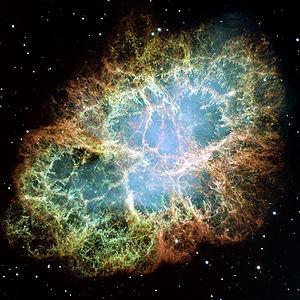 The Crab Nebula, the shattered remnants of a star which exploded as a supernova, the light of which reached Earth in 1054 AD
The Crab Nebula, the shattered remnants of a star which exploded as a supernova, the light of which reached Earth in 1054 AD
In massive stars, the core is already large enough at the onset of hydrogen burning shell that helium ignition will occur before electron degeneracy pressure has a chance to become prevalent. Thus, when these stars expand and cool, they do not brighten as much as lower mass stars; however, they were much brighter than lower mass stars to begin with, and are thus still brighter than the red giants formed from less massive stars. These stars are unlikely to survive as red supergiants; instead they will destroy themselves as type II supernovas.
Extremely massive stars (more than approximately 40 solar masses), which are very luminous and thus have very rapid stellar winds, lose mass so rapidly due to radiation pressure that they tend to strip off their own envelopes before they can expand to become red supergiants, and thus retain extremely high surface temperatures (and blue-white color) from their main sequence time onwards. Stars cannot be more than about 120 solar masses because the outer layers would be expelled by the extreme radiation. Although lower mass stars normally do not burn off their outer layers so rapidly, they can likewise avoid becoming red giants or red supergiants if they are in binary systems close enough so that the companion star strips off the envelope as it expands, or if they rotate rapidly enough so that convection extends all the way from the core to the surface, resulting in the absence of a separate core and envelope due to thorough mixing.[5]
The core grows hotter and denser as it gains material from fusion of hydrogen at the base of the envelope. In all massive stars, electron degeneracy pressure is insufficient to halt collapse by itself, so as each major element is consumed in the center, progressively heavier elements ignite, temporarily halting collapse. If the core of the star is not too massive (less than approximately 1.4 solar masses, taking into account mass loss that has occurred by this time), it may then form a white dwarf (possibly surrounded by a planetary nebula) as described above for less massive stars, with the difference that the white dwarf is composed chiefly of oxygen, neon, and magnesium.
Above a certain mass (estimated at approximately 2.5 solar masses and whose star's progenitor was around 10 solar masses), the core will reach the temperature (approximately 1.1 gigakelvins) at which neon partially breaks down to form oxygen and helium, the latter of which immediately fuses with some of the remaining neon to form magnesium; then oxygen fuses to form sulfur, silicon, and smaller amounts of other elements. Finally, the temperature gets high enough that any nucleus can be partially broken down, most commonly releasing an alpha particle (helium nucleus) which immediately fuses with another nucleus, so that several nuclei are effectively rearranged into a smaller number of heavier nuclei, with net release of energy because the addition of fragments to nuclei exceeds the energy required to break them off the parent nuclei.
A star with a core mass too great to form a white dwarf but insufficient to achieve sustained conversion of neon to oxygen and magnesium, will undergo core collapse (due to electron capture) before achieving fusion of the heavier elements.[6] Both heating and cooling caused by electron capture onto minor constituent elements (such as aluminum and sodium) prior to collapse may have a significant impact on total energy generation within the star shortly before collapse.[7] This may produce a noticeable effect on the abundance of elements and isotopes ejected in the subsequent supernova.
Once the nucleosynthesis process arrives at iron-56, the continuation of this process consumes energy (the addition of fragments to nuclei releases less energy than required to break them off the parent nuclei). If the mass of the core exceeds the Chandrasekhar limit, electron degeneracy pressure will be unable to support its weight against the force of gravity, and the core will undergo sudden, catastrophic collapse to form a neutron star or (in the case of cores that exceed the Tolman-Oppenheimer-Volkoff limit), a black hole. Through a process that is not completely understood, some of the gravitational potential energy released by this core collapse is converted into a Type Ib, Type Ic, or Type II supernova. It is known that the core collapse produces a massive surge of neutrinos, as observed with supernova SN 1987A. The extremely energetic neutrinos fragment some nuclei; some of their energy is consumed in releasing nucleons, including neutrons, and some of their energy is transformed into heat and kinetic energy, thus augmenting the shock wave started by rebound of some of the infalling material from the collapse of the core. Electron capture in very dense parts of the infalling matter may produce additional neutrons. As some of the rebounding matter is bombarded by the neutrons, some of its nuclei capture them, creating a spectrum of heavier-than-iron material including the radioactive elements up to (and likely beyond) uranium.[8] Although non-exploding red giant stars can produce significant quantities of elements heavier than iron using neutrons released in side reactions of earlier nuclear reactions, the abundance of elements heavier than iron (and in particular, of certain isotopes of elements that have multiple stable or long-lived isotopes) produced in such reactions is quite different from that produced in a supernova. Neither abundance alone matches that found in the Solar System, so both supernovae and ejection of elements from red giant stars are required to explain the observed abundance of heavy elements and isotopes thereof.
The energy transferred from collapse of the core to rebounding material not only generates heavy elements, but (by a mechanism which is not fully understood) provides for their acceleration well beyond escape velocity, thus causing a Type Ib, Type Ic, or Type II supernova. Note that current understanding of this energy transfer is still not satisfactory; although current computer models of Type Ib, Type Ic, and Type II supernovae account for part of the energy transfer, they are not able to account for enough energy transfer to produce the observed ejection of material.[9] Some evidence gained from analysis of the mass and orbital parameters of binary neutron stars (which require two such supernovae) hints that the collapse of an oxygen-neon-magnesium core may produce a supernova that differs observably (in ways other than size) from a supernova produced by the collapse of an iron core.[10]
The most massive stars may be completely destroyed by a supernova with an energy greatly exceeding its gravitational binding energy. This rare event, caused by pair-instability, leaves behind no black hole remnant.[11]
Stellar remnants
After a star has burned out its fuel supply, its remnants can take one of three forms, depending on the mass during its lifetime.
White and black dwarfs
Main article: White dwarfFor a star of 1 solar mass, the resulting white dwarf is of about 0.6 solar mass, compressed into approximately the volume of the Earth. White dwarfs are stable because the inward pull of gravity is balanced by the degeneracy pressure of the star's electrons. (This is a consequence of the Pauli exclusion principle.) Electron degeneracy pressure provides a rather soft limit against further compression; therefore, for a given chemical composition, white dwarfs of higher mass have a smaller volume. With no fuel left to burn, the star radiates its remaining heat into space for billions of years.
A white dwarf is initially very hot when it first forms, more than 100,000 degrees K at the surface and even hotter in its interior. It is so hot that a lot of its energy is lost in the form of neutrinos for the first 10 million years of its existence, but will have lost most of its energy after a billion years. [12]
The chemical composition of the white dwarf depends upon its mass. A star of a few solar masses will ignite carbon fusion to form magnesium, neon, and smaller amounts of other elements, resulting in a white dwarf composed chiefly of oxygen, neon, and magnesium, provided that it can lose enough mass to get below the Chandrasekhar limit (see below), and provided that the ignition of carbon is not so violent as to blow the star apart in a supernova.[13] A star of mass on the order of magnitude of the Sun will be unable to ignite carbon fusion, and will produce a white dwarf composed chiefly of carbon and oxygen, and of mass too low to collapse unless matter is added to it later (see below). A star of less than about half the mass of the Sun will be unable to ignite helium fusion (as noted earlier), and will produce a white dwarf composed chiefly of helium.
In the end, all that remains is a cold dark mass sometimes called a black dwarf. However, the universe is not old enough for any black dwarf stars to exist yet.
If the white dwarf's mass increases above the Chandrasekhar limit, which is 1.4 solar masses for a white dwarf composed chiefly of carbon, oxygen, neon, and/or magnesium, then electron degeneracy pressure fails due to electron capture and the star collapses. Depending upon the chemical composition and pre-collapse temperature in the center, this will lead either to collapse into a neutron star or runaway ignition of carbon and oxygen. Heavier elements favor continued core collapse, because they require a higher temperature to ignite, because electron capture onto these elements and their fusion products is easier; higher core temperatures favor runaway nuclear reaction, which halts core collapse and leads to a Type Ia supernova.[14] These supernovae may be many times brighter than the Type II supernova marking the death of a massive star, even though the latter has the greater total energy release. This inability to collapse means that no white dwarf more massive than approximately 1.4 solar masses can exist (with a possible minor exception for very rapidly spinning white dwarfs, whose centrifugal force due to rotation partially counteracts the weight of their matter). Mass transfer in a binary system may cause an initially stable white dwarf to surpass the Chandrasekhar limit.
If a white dwarf forms a close binary system with another star, hydrogen from the larger companion may accrete around and onto a white dwarf until it gets hot enough to fuse in a runaway reaction at its surface, although the white dwarf remains below the Chandrasekhar limit. Such an explosion is termed a nova.
Neutron stars
Main article: Neutron star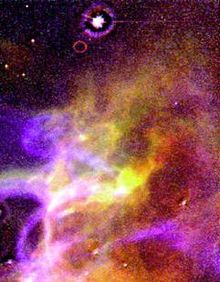 Bubble-like shock wave still expanding from a supernova explosion 15,000 years ago.
Bubble-like shock wave still expanding from a supernova explosion 15,000 years ago.
(view here for larger image.)When a stellar core collapses, the pressure causes electron capture, thus converting the great majority of the protons into neutrons. The electromagnetic forces keeping separate nuclei apart are gone (proportionally, if nuclei were the size of dust mites, atoms would be as large as football stadiums), and most of the core of the star becomes a dense ball of contiguous neutrons (in some ways like a giant atomic nucleus), with a thin overlying layer of degenerate matter (chiefly iron unless matter of different composition is added later). The neutrons resist further compression by the Pauli Exclusion Principle, in a way analogous to electron degeneracy pressure, but stronger.
These stars, known as neutron stars, are extremely small–on the order of radius 10 km, no bigger than the size of a large city–and are phenomenally dense. Their period of revolution shortens dramatically as the star shrinks (due to conservation of angular momentum); some spin at over 600 revolutions per second. When these rapidly rotating stars' magnetic poles are aligned with the Earth, we detect a pulse of radiation each revolution. Such neutron stars are called pulsars, and were the first neutron stars to be discovered.
Black holes
Main article: Black holeIf the mass of the stellar remnant is high enough, the neutron degeneracy pressure will be insufficient to prevent collapse below the Schwarzschild radius. The stellar remnant thus becomes a black hole. The mass at which this occurs is not known with certainty, but is currently estimated at between 2 and 3 solar masses.
Black holes are predicted by the theory of general relativity. According to classical general relativity, no matter or information can flow from the interior of a black hole to an outside observer, although quantum effects may allow deviations from this strict rule. The existence of black holes in the universe is well supported, both theoretically and by astronomical observation.
Since the core-collapse supernova mechanism itself is imperfectly understood, it is still not known whether it is possible for a star to collapse directly to a black hole without producing a visible supernova, or whether some supernovae initially form unstable neutron stars which then collapse into black holes; the exact relation between the initial mass of the star and the final remnant is also not completely certain. Resolution of these uncertainties requires the analysis of more supernovae and supernova remnants.
Models
A stellar evolutionary model is a mathematical model that can be used to compute the evolutionary phases of a star from its formation until it becomes a remnant. The mass and chemical composition of the star are used as the inputs, and the luminosity and surface temperature are the only constraints. The model formulae are based upon the physical understanding of the star, usually under the assumption of hydrostatic equilibrium. Extensive computer calculations are then run to determine the changing state of the star over time, yielding a table of data that can be used to determine the evolutionary track of the star across the HR diagram, along with other evolving properties.[15] Accurate models can be used to estimate the current age of a star by comparing its physical properties with those of stars along a matching evolutionary track.[16]
See also
References
- ^ Dina Prialnik (2000). An Introduction to the Theory of Stellar Structure and Evolution. Cambridge University Press. chapter 10. ISBN 0521650658.
- ^ "Why the Smallest Stars Stay Small". Sky & Telescope (22). November 1997.
- ^ Alan C. Edwards (1969). "The hydrodynamics of the helium flash". Monthly Notices of the Royal Astronomical Society 146: 445–472. Bibcode 1969MNRAS.146..445E.
- ^ I. Juliana Sackmann et al. (1993). "Our Sun. III. Present and Future". The Astrophysical Journal 418: 457–468. Bibcode 1993ApJ...418..457S. doi:10.1086/173407.
- ^ D. Vanbeveren; De Loore, C.; Van Rensbergen, W. (1998). "Massive stars". The Astronomy and Astrophysics Review 9 (1-2): 63–152. Bibcode 1998A&ARv...9...63V. doi:10.1007/s001590050015. Archived from the original on 2009-03-27. http://replay.waybackmachine.org/20090327051442/http://www.astro.phys.ethz.ch/staff/schmid/private/PSbinary/vanbeveren98.pdf.
- ^ Ken'ichi Nomoto (1987). "Evolution of 8-10 solar mass stars toward electron capture supernovae. II - Collapse of an O + Ne + Mg core". Astrophysical Journal. 322 Part 1: 206–214. Bibcode 1987ApJ...322..206N. doi:10.1086/165716.
- ^ Claudio Ritossa et al. (1999). "On the Evolution of Stars that Form Electron-degenerate Cores Processed by Carbon Burning. V. Shell Convection Sustained by Helium Burning, Transient Neon Burning, Dredge-out, URCA Cooling, and Other Properties of an 11 M_solar Population I Model Star". The Astrophysical Journal 515 (1): 381–397. Bibcode 1999ApJ...515..381R. doi:10.1086/307017.
- ^ How do Massive Stars Explode?
- ^ Supernova Simulations Still Defy Explosions.
- ^ E. P. J. van den Heuvel (2004). "X-Ray Binaries and Their Descendants: Binary Radio Pulsars; Evidence for Three Classes of Neutron Stars?". Proceedings of the 5th INTEGRAL Workshop on the INTEGRAL Universe (ESA SP-552) 552: 185–194. arXiv:astro-ph/0407451. Bibcode 2004inun.conf..185V.
- ^ Pair Instability Supernovae and Hypernovae., Nicolay J. Hammer, (2003), accessed May 7, 2007.
- ^ Fossil Stars (1): White Dwarfs
- ^ Ken'ichi Nomoto (1984). "Evolution of 8-10 solar mass stars toward electron capture supernovae. I - Formation of electron-degenerate O + Ne + Mg cores". Astrophysical Journal. 277 Part 1: 791–805. Bibcode 1984ApJ...277..791N. doi:10.1086/161749.
- ^ Ken'ichi Nomoto and Yoji Kondo (1991). "Conditions for accretion-induced collapse of white dwarfs". Astrophysical Journal. 367 Part 2: L19–L22. Bibcode 1991ApJ...367L..19N. doi:10.1086/185922.
- ^ Demarque, P.; Guenther, D. B.; Li, L. H.; Mazumdar, A.; Straka, C. W. (August 2008). "YREC: the Yale rotating stellar evolution code". Astrophysics and Space Science 316 (1–4): 31–41. Bibcode 2008Ap&SS.316...31D. doi:10.1007/s10509-007-9698-y. http://books.google.com/books?id=WjU_vidlXRwC&pg=PA35.
- ^ Ryan, Seán; Norton, Andrew J. (2010). "Assigning ages from hydrogen-burning timescales". Stellar Evolution and Nucleosynthesis. Cambridge University Press. p. 79. ISBN 0521133203. http://books.google.com/books?id=PE4yGiU-JyEC&pg=PA79.
Further reading
- Astronomy 606 (Stellar Structure and Evolution) lecture notes, Cole Miller, Department of Astronomy, University of Maryland
- Astronomy 162, Unit 2 (The Structure & Evolution of Stars) lecture notes, Richard W. Pogge, Department of Astronomy, Ohio State University
Categories:- Stellar evolution
- Stellar astronomy
Wikimedia Foundation. 2010.

